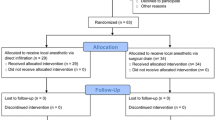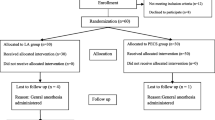Abstract
Introduction
We evaluated the impact of topical epinephrine with xylocaine on drainage after axillary lymph node dissection.
Methods
Fifty-two women were randomized into two groups, epinephrine with xylocaine drainage (ED) and conventional drainage group (CD). The amount of drainage, duration of drainage catheter, incidence of seroma formation and wound infection were noted.
Results
The mean total drainage volume was less in ED group as compared to CD group (195 ml vs. 353 ml; p = .002). Drainage catheter was removed earlier in ED group as compared to CD group (5.07 + / − 0.99 days vs. 6.65 + / − 1.07 days; p = 0.0001). The incidence of seroma and wound infection was similar in two groups.
Conclusion
Topical epinephrine with xylocaine after axillary lymph node dissection results in significantly decreased drainage volume and duration of drainage.



Similar content being viewed by others
References
Kwon S, Sevick-Muraca EM (2016) Effect of lidocaine with and without epinephrine on lymphatic contractile activity in mice in vivo. J Anesth 30(6):1091–1094. https://doi.org/10.1007/s00540-016-2260-8
Thomson DR, Trevatt AE, Furniss D (2016) When should axillary drains be removed? a meta-analysis of time-limited versus volume controlled strategies for timing of drain removal following axillary lymphadenectomy. J Plast Reconstr Aesthet Surg 69(12):1614–1620. https://doi.org/10.1016/j.bjps.2016.09.027
Lohani KR, Kumar C, Kataria K, Srivastava A, Ranjan P, Dhar A (2020) Role of tranexamic acid in axillary lymph node dissection in breast cancer patients. Breast J. https://doi.org/10.1111/tbj.13810
Spiekerman van Weezelenburg MA, de Rooij L, Aldenhoven L, Broos PPHL, van Kuijk SMJ, van Haaren ERM, Janssen A, Vissers YLJ, Beets GL, van Bastelaar J (2022) Evaluating HEmopatch® in reducing seroma-related complications following axillary lymph node dissection: a pilot study (HEIDI). Breast Care (Basel) 17(6):567–572. https://doi.org/10.1159/000525839
Classe JM, Berchery D, Campion L, Pioud R, Dravet F, Robard S (2006) Randomized clinical trial comparing axillary padding with closed suction drainage for the axillary wound after lymphadenectomy for breast cancer. Br J Surg 93(7):820–824. https://doi.org/10.1002/bjs.5433. (PMID: 16775817)
Zavotsky J, Jones RC, Brennan MB, Guiliano AE (1998) Evaluation of axillary lymphadenectomy without axillary drainage for patients undergoing breast-conserving therapy. Ann Surg Oncol 5:227–231
Kesici S, Demirci M, Kesici U (2019) Antibacterial effects of lidocaine and adrenaline. Int Wound J 16(5):1190–1194. https://doi.org/10.1111/iwj.13182
Razavi BM, Fazly Bazzaz BS (2019) A review and new insights to antimicrobial action of local anesthetics. Eur J Clin Microbiol Infect Dis 38(6):991–1002. https://doi.org/10.1007/s10096-018-03460-4
Agrawal A, Ayantunde AA, Cheung KL (2006) Concepts of seroma formation and prevention in breast cancer surgery. ANZ J Surg 76(12):1088–1095. https://doi.org/10.1111/j.1445-2197.2006.03949.x
Kuroi K, Shimozuma K, Taguchi T, Imai H, Yamashiro H, Ohsumi S, Saito S (2006) Evidence-based risk factors for seroma formation in breast surgery. Jpn J Clin Oncol 36(4):197–206. https://doi.org/10.1093/jjco/hyl019
Faisal M, Abu-Elela ST, Mostafa W, Antar O (2016) Efficacy of axillary exclusion on seroma formation after modified radical mastectomy. World J Surg Oncol 14(1):39. https://doi.org/10.1186/s12957-016-0801-0
Droeser RA, Frey DM, Oertli D, Kopelman D, Baas-Vrancken Peeters MJ, Giuliano AE, Dalberg K, Kallam R, Nordmann A (2009) Volume-controlled vs no/short-term drainage after axillary lymph node dissection in breast cancer surgery: a meta-analysis. Breast 18(2):109–114. https://doi.org/10.1016/j.breast.2009.02.003
He XD, Guo ZH, Tian JH, Yang KH, Xie XD (2011) Whether drainage should be used after surgery for breast cancer? a systematic review of randomized controlled trials. Med Oncol 28(Suppl 1):S22-30. https://doi.org/10.1007/s12032-010-9673-2
Thomson DR, Sadideen H, Furniss D (2013) 2013 Wound drainage after axillary dissection for carcinoma of the breast. Cochrane Database Syst Rev 10:CD006823. https://doi.org/10.1002/14651858.CD006823.pub2
Freitas-Junior R, Ribeiro LFJ, Moreira MAR, Queiroz GS, Esperidião MD, Silva MAC et al (2017) Complete axillary dissection without drainage for the surgical treatment of breast cancer: a randomized clinical trial. Clinics (Sao Paulo) 72(7):426–431. https://doi.org/10.6061/clinics/2017(07)07
Wells M, Harrow A, Donnan P, Davey P, Devereux S, Little G et al (2004) Patient, carer and health service outcomes of nurse-led early discharge after breast cancer surgery: a randomised controlled trial. Br J Cancer 91:651–658
Chintamani SV, Singh J, Bansal A, Saxena S (2005) Half versus full vacuum suction drainage after modified radical mastectomy for breast cancer- a prospective randomized clinical trial [ISRCTN24484328]. BMC Cancer 5:11. https://doi.org/10.1186/1471-2407-5-11
van Bemmel AJ, van de Velde CJ, Schmitz RF, Liefers GJ (2011) Prevention of seroma formation after axillary dissection in breast cancer: a systematic review. Eur J Surg Oncol 37(10):829–835. https://doi.org/10.1016/j.ejso.2011.04.012
Kottayasamy Seenivasagam R, Gupta V, Singh G (2013) Prevention of seroma formation after axillary dissection–a comparative randomized clinical trial of three methods. Breast J 19(5):478–484. https://doi.org/10.1111/tbj.12164
Eliav T, Novack V, Krieger Y (2021) Effect of quilting on seroma formation in mastectomies: a meta-analysis. Surg Oncol 39:101665. https://doi.org/10.1016/j.suronc.2021.101665
Velotti N, Limite G, Vitiello A, Berardi G, Musella M (2021) Flap fixation in preventing seroma formation after mastectomy: an updated meta-analysis. Updates Surg 73(4):1307–1314. https://doi.org/10.1007/s13304-021-01049-9
Morarasu S, Clancy C, Ghetu N, Musina AM, Velenciuc N, Iacob S, Frunza T, Roata CE, Lunca S, Dimofte GM (2022) Impact of quilting sutures on surgical outcomes after mastectomy: a systematic review and meta-analysis. Ann Surg Oncol 29(6):3785–3797. https://doi.org/10.1245/s10434-022-11350-5
Oertli D, Laffer U, Haberthuer F, Kreuter U, Harder F (1994) Perioperative and postoperative tranexamic acid reduces the local wound complication rate after surgery for breast cancer. Br J Surg 81(6):856–859. https://doi.org/10.1002/bjs.1800810621
Cipolla C, Fricano S, Vieni S, Graceffa G, Licari G, Torcivia A, Latteri MA (2010) Does the use of fibrin glue prevent seroma formation after axillary lymphadenectomy for breast cancer? a prospective randomized trial in 159 patients. J Surg Oncol 101(7):600–603. https://doi.org/10.1002/jso.21531
Sajid MS, Hutson K, Kalra L, Bonomi R (2012) The role of fibrin glue instillation under skin flaps in the prevention of seroma formation and related morbidities following breast and axillary surgery for breast cancer: a meta-analysis. J Surg Oncol 106(6):783–795. https://doi.org/10.1002/jso.23140
Vasileiadou K, Kosmidis C, Anthimidis G, Miliaras S, Kostopoulos I, Fahantidis E (2017) Cyanoacrylate adhesive reduces seroma production after modified radical mastectomy or quadrantectomy with lymph node dissection-a prospective randomized clinical trial. Clin Breast Cancer 17(8):595–600. https://doi.org/10.1016/j.clbc.2017.04.004
Calpin GG, McAnena PF, Davey MG, Calpin P, Kerin MJ, McInerney N et al (2022) The role of tranexamic acid in reducing post-operative bleeding and seroma formation in breast surgery: a meta-analysis. Surgeon. https://doi.org/10.1016/j.surge.2022.11.005
Chéreau E, Uzan C, Boutmy-Deslandes E, Zohar S, Bézu C, Mazouni C et al (2016) Evaluation of the effects of pasireotide LAR administration on lymphocele prevention after axillary node dissection for breast cancer: results of a randomized non-comparative phase 2 study. PLoS ONE 11(6):e0156096. https://doi.org/10.1371/journal.pone.0156096
Gambardella C, Clarizia G, Patrone R, Offi C, Mauriello C, Romano R et al (2019) Advanced hemostasis in axillary lymph node dissection for locally advanced breast cancer: new technology devices compared in the prevention of seroma formation. BMC Surg 18(Suppl 1):125. https://doi.org/10.1186/s12893-018-0454-8
Isozaki H, Yamamoto Y, Murakami S, Matsumoto S, Takama T (2019) Impact of the surgical modality for axillary lymph node dissection on postoperative drainage and seroma formation after total mastectomy. Patient Saf Surg 14(13):20. https://doi.org/10.1186/s13037-019-0199-z
Spiekerman van Weezelenburg MA, de Rooij L, Aldenhoven L, Broos PPHL, van Kuijk SMJ, van Haaren ERM et al (2022) Evaluating HEmopatch® in reducing seroma-related complications following axillary lymph node dissection: a pilot study (HEIDI). Breast Care (Basel) 17(6):567–572. https://doi.org/10.1159/000525839
Troost MS, Kempees CJ, de Roos MAJ (2015) Breast cancer surgery without drains: no influence on seroma formation. Int J Surg 13:170–174. https://doi.org/10.1016/j.ijsu.2014.11.050
Bharath S, Yadav SK, Sharma D, Agarwal P, Jha S, Shekhar S, Sharma DB, Mishra A (2023) LMIC patients’ perspectives after surgery related complications among breast cancer patients. Ind J Surg Oncol. https://doi.org/10.1007/s13193-023-01721-z
Anand A, Mishra A, Damde H et al (2022) Molecular profile and clinico-pathological characteristics of breast cancer in central india: first investigative report. Indian J Surg Oncol 13:421–425. https://doi.org/10.1007/s13193-022-01502-0
Author information
Authors and Affiliations
Corresponding author
Additional information
Publisher's Note
Springer Nature remains neutral with regard to jurisdictional claims in published maps and institutional affiliations.
Supplementary Information
Below is the link to the electronic supplementary material.
Rights and permissions
Springer Nature or its licensor (e.g. a society or other partner) holds exclusive rights to this article under a publishing agreement with the author(s) or other rightsholder(s); author self-archiving of the accepted manuscript version of this article is solely governed by the terms of such publishing agreement and applicable law.
About this article
Cite this article
Dehariya, P., Agarwal, N., Yadav, S.K. et al. Impact of Topical Epinephrine with Xylocaine on Drainage After Axillary Lymph Node Dissection: A Randomized Controlled Trial. World J Surg 47, 2761–2766 (2023). https://doi.org/10.1007/s00268-023-07139-6
Accepted:
Published:
Issue Date:
DOI: https://doi.org/10.1007/s00268-023-07139-6




